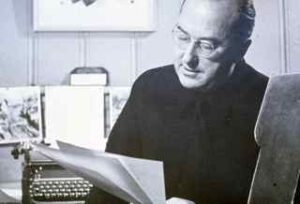Creating Fictional Characters – The Magic of “Who?”
May 29, 2013 by ciji · Leave a Comment
 When starting a new project–as I am doing with That Autumn in Edinburgh, a novel that follows the previously published That Summer in Cornwall in my Four Seasons series—I fall back on twenty-five years experience as a working reporter. I have always found asking those journalists’ questions: who, what, where, why, when to be rather magical in the way they find me the answers I need to get started.
When starting a new project–as I am doing with That Autumn in Edinburgh, a novel that follows the previously published That Summer in Cornwall in my Four Seasons series—I fall back on twenty-five years experience as a working reporter. I have always found asking those journalists’ questions: who, what, where, why, when to be rather magical in the way they find me the answers I need to get started.
“Where?” is obvious for this novel: Scotland, and more specifically, Edinburgh and the territory south of the city known as the Scottish Borders where the Maxwell Clan held prominence since the 1400s. (Caerlaverock Castle, here, was one of their strongholds).
But once the setting is decided, Question #2 becomes: Who is this novel about?
For me, the only way to figure this out is to start with a name,in this case “Alexander Maxwell,” and then do a “handmade” fictional genealogy chart for the protagonist that goes back at least four generations on both sides of the person: parents, grandparents, great-grandparents, great-great-grandparents.
 Since this book is a contemporary spin-off of the first novel I ever published, Island of the Swans, I had to create a genealogy chart that went back a couple of centuries! The trickiest part has been that Swans was a biographical historical novel based on an actual historical figure, Jane Maxwell of Monreith, 4th Duchess of Gordon (1749-1812). Figuring out how my modern-day fictional hero could be related to the Duchess’ branch of Clan Maxwell 250-plus years later took some serious research, especially as I discovered that most of the various branches of the Scottish Maxwell clan and the Dukedom of Gordon died out with no male heir.
Since this book is a contemporary spin-off of the first novel I ever published, Island of the Swans, I had to create a genealogy chart that went back a couple of centuries! The trickiest part has been that Swans was a biographical historical novel based on an actual historical figure, Jane Maxwell of Monreith, 4th Duchess of Gordon (1749-1812). Figuring out how my modern-day fictional hero could be related to the Duchess’ branch of Clan Maxwell 250-plus years later took some serious research, especially as I discovered that most of the various branches of the Scottish Maxwell clan and the Dukedom of Gordon died out with no male heir.
Fortunately, there was one branch of the Maxwells descending from Jane who had made it into the 21st Century: Sir Michael Eustace Maxwell, 9th Baronet of Monreith from a region southwest of Edinburgh in the Scottish Borders.
Sir Michael, however, at 70, remains a bachelor with a 150-year-old manor house in serious need of refurbishment—so much so that he was profiled on a “reality” program in Britain, Country House Rescue with Ruth Watson, seen here, in which the presenter’s best recommendation was for the last heir to marry a woman with some interior design talents and a considerable fortune! If they somehow produced a male heir, so much the better. (At last Google-ing, this had not transpired…). Sadly, various areas on the estate such as this crumbling, moss-covered lodge were near to collapsing.
So what to do…what to do? And then I had a stroke of what I can only consider semi-brilliance! 
Jane Maxwell– seen here on her horse recruiting Highland soldiers to fight in the 78th Fraser Highlanders against the colonists in the American War of Independence– had seven children, one of whom was most assuredly not by the Duke of Gordon.
What if, in the early twentieth century, there was born to a housemaid in the employ of the Maxwells of Monreith a baby boy whose features had the unmistakable stamp of several of the Maxwell males of that pre-World War I era—but whose father always remained a mystery?
Typical of the times, the baby–who could never inherit the title nor the estate– could have been placed with a childless couple in a neighboring village to raise, and only later, upon receiving a deathbed bequest of funds from his guilty sire, does my hero’s great grandfather discover he’s a Maxwell of Monreith–even if born “on the wrong side of the blanket.”
 See how deviously we spinner-of-tales can work around any factual problems?
See how deviously we spinner-of-tales can work around any factual problems?
But I want my modern-day hero, the 35-year-old Alex Maxwell, to be the owner of a tartan mill in the Scottish Borders that’s teetering on the edge of bankruptcy due to unholy competition from textile manufacturers who are under-cutting his prices in the Far East by using cheap labor.
But hold on a sec! How could the descendant of an illegitimate child of the Maxwell clan have advanced far enough in three generations to be owner of a substantial woolen manufacturing enterprise?
Ah, remember that bequest? Well, therein lies the tale…but first I need to learn about the “what” in this who. what. where, why, & when novel-writing equation: the tartan weaving industry.
At left is a model at one of the prominent Scottish woolen firms whose good looks I find quite inspiring, so it’s off to the Scotland I must go….
Filed under Blog, Ciji's Archives · Tagged with Ciji Ware author, Clan Maxwell, Cornwall, eighteenth century British history, eighteenth century Scottish history, Fourth Duchess of Gordon, genealogy, historical novels, Island of the Swans, Jane Maxwell, journalistic tools, Maxwells of Monreith, Scottish woolen industry, tartan mills, tartan weaving, tartans, That Summer in Cornwall, truth versus fiction, TV presenter Ruth Watson
Scotland by the Yard
May 26, 2013 by ciji · Leave a Comment
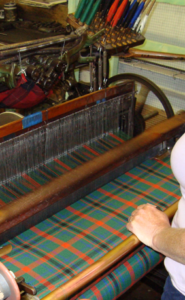 The first thing a person learns about Scottish woolen manufacturing—an industry which will figure in the background of the next novel after That Summer in Cornwall in my forthcoming Four Seasons Quartet series—is that the vibrantly patterned cloth for which Scotland is so renowned may be called “plaid” by the uninitiated, but in the region of Scotland where much of it is made, you’d be well-advised to call it “tartan”—as in “family tartan.”
The first thing a person learns about Scottish woolen manufacturing—an industry which will figure in the background of the next novel after That Summer in Cornwall in my forthcoming Four Seasons Quartet series—is that the vibrantly patterned cloth for which Scotland is so renowned may be called “plaid” by the uninitiated, but in the region of Scotland where much of it is made, you’d be well-advised to call it “tartan”—as in “family tartan.”
In the novel I’m currently researching, That Autumn in Edinburgh, an American home furnishings designer named Fiona Fraser determines to rely on her Scottish-American heritage to create an entirely new Home Collection for the legendary fashion and lifestyle tycoon she works for. I spent a great day recently cruising around the Worldwide Web, peering into the stately homes north of England and searching the pages of shelter magazines that offer the kind of inspiration that fires my heroine Fiona’s imagination as she travels around Scotland.
 In the process, she battles to rescue her brother’s failing furniture company in North Carolina, as well as a tartan mill in Scotland (where, of course, we meet our hero, Alex Maxwell) that’s on the brink of bankruptcy due to Far East competition stealing traditional designs and making cheaper versions with labor that’s paid less than forty dollars a month.
In the process, she battles to rescue her brother’s failing furniture company in North Carolina, as well as a tartan mill in Scotland (where, of course, we meet our hero, Alex Maxwell) that’s on the brink of bankruptcy due to Far East competition stealing traditional designs and making cheaper versions with labor that’s paid less than forty dollars a month.
In the process of preparing for my upcoming trip to the Scottish Borders region to steep myself in the Scottish woolen and cashmere trade, I encountered a website called “The Tartans Authority” — and what a world it opened up to me! This non-profit organization created the “Tartan Ferret” –a little critter who attempts to match the name you type into the search box with the correct color version of “your” family tartan.
 Instead of immediately delving into the tasks I’d assigned myself, I couldn’t resist looking up the various tartans that are linked with the plethora of Scottish surnames I have on both sides of my and my husband’s family. My initial foray into exploring officially-recognized designs was made rather easy since both Tony and I have the names “Bell” and “Alexander/McAlister” in our family tree. I typed in “Bell” and bingo! There it was in all its rather muted glory.
Instead of immediately delving into the tasks I’d assigned myself, I couldn’t resist looking up the various tartans that are linked with the plethora of Scottish surnames I have on both sides of my and my husband’s family. My initial foray into exploring officially-recognized designs was made rather easy since both Tony and I have the names “Bell” and “Alexander/McAlister” in our family tree. I typed in “Bell” and bingo! There it was in all its rather muted glory.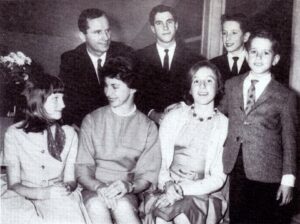
One of the great moments of our marriage was when Tony’s late father, seen here with his five children, was visiting from New York and corrected my husband’s belief that the Cook family was pure English on both sides, a notion reinforced by living with his proper, tea-pouring English maternal grandmother as a tiny boy when his dad was fighting in the Pacific theater in World War II.
 “Oh, no, Tony! “ Howard Cook exclaimed. “Our name was originally MacCook, but some ancestor wanted the family to sound more American than Scottish and so lopped off the ‘Mac.’” I typed in those names for the Tartan Ferret to seek, and Hoot Mon, the right version came up on the screen in a nano-second!
“Oh, no, Tony! “ Howard Cook exclaimed. “Our name was originally MacCook, but some ancestor wanted the family to sound more American than Scottish and so lopped off the ‘Mac.’” I typed in those names for the Tartan Ferret to seek, and Hoot Mon, the right version came up on the screen in a nano-second!
You never know what you’ll learn when you begin looking into all this ancestor business. Tony’s mother’s name was “Pattison” (with an “i”…not an “er”) and his grandfather, Lee Pattison, was a celebrated half of a concertizing dual piano team, Maier & Pattison. For some reason I thought his name might be Scandinavian, as in Peterson, but lo and behold, I put “Pattison” into the Tartan Authority search box and up came a tiny swatch of the Lowland family’s very own named tartan.
 So, my heroine, Fiona, clearly has her work cut out for her as she explores the country of her forbears and begins to understand Scotland by the yard…
So, my heroine, Fiona, clearly has her work cut out for her as she explores the country of her forbears and begins to understand Scotland by the yard…
And that goes for yours truly, as well. I can’t wait to see what the MacCook tartan looks like in the flesh. Don’t you think a waistcoat made out of that fabric would make a great Christmas present? Shhhh….don’t spoil the surprise….
Filed under Blog, Ciji's Archives · Tagged with ancestry, cashmere knitting mills, Chinese stealing US intellectual property, Ciji Ware author, eighteenth century British history, eighteenth century Scottish history, Family tartans, finding your family tartan, finding your roots, furniture manufacturing in the US, global competition, interior design, Lowlands of Scotland, Plaid, researching a novel, Scottish interiors, Scottish woolen industry, That Summer in Cornwall, weaving industry
Are Ancestors “Fair Game” in Fiction?
May 20, 2013 by ciji · Leave a Comment
 I remember when I was a young consumer reporter in my early days at ABC—long before I’d written or published novels like That Summer in Cornwall —when the subject of one of my radio assignments became very angry that I revealed that his company was pumping air into its ice cream to increase the bulk (and hence the weight) which, of course, meant they could charge-more-for-less.
I remember when I was a young consumer reporter in my early days at ABC—long before I’d written or published novels like That Summer in Cornwall —when the subject of one of my radio assignments became very angry that I revealed that his company was pumping air into its ice cream to increase the bulk (and hence the weight) which, of course, meant they could charge-more-for-less.
I told a veteran newspaperman about the significant blowback I received from Mr. Ice Cream and the head of the station’s ad department after the story aired, given that the chain where this tasty treat was sold turned out to be one of KABC’s biggest advertisers…oops! The old media hand gave me one of his droll looks and said, “Oh, I guess I forgot to warn you, Ciji. People who think they are important only want to be described in the noblest of terms. However, you’ll just have to ignore that and tell the truth.” That, he added, was my purpose as a reporter.
 I ran into an alarmingly similar problem when I was researching my first historical novel, Island of the Swans, a kind of a Gone with the Wind of Scotland saga that was based on the life of an historical figure, Jane Maxwell, the 4th Duchess of Gordon.
I ran into an alarmingly similar problem when I was researching my first historical novel, Island of the Swans, a kind of a Gone with the Wind of Scotland saga that was based on the life of an historical figure, Jane Maxwell, the 4th Duchess of Gordon.
I had contacted a descendant of one of the other “true-life” figures in this biographical novel, Baron Simon, the 15th Lord Lovat of Fraser, a celebrated World War II hero (played by Peter Lawford in the classic The Longest Day) who, along with his wife, Lady Rose, eventually hosted my son and me as guests at Balblair House for a few days on one of our trips to the Highlands to track down the important details of the amazing Duchess’ tumultuous life.
I had landed on the Lovats’ doorstep—literally—in search of information about the “lost lieutenant,” Thomas Fraser of Struy, who had erroneously been reported killed in the American Colonies while serving with the Black Watch regiment at Fort Pitt—now Pittsburgh, Pennsylvania.
I soon began to get that same, uneasy feeling when an eighteenth century Lord Lovat, painted here by Hogarth, was beginning to emerge as a slightly villainous figure in my story, preventing, it turned out, the lovely Jane Maxwell (from whom my own great grand-grandmother claimed our McCulloughs descended) from marrying the great love of her life, the aforementioned Simon Fraser’s ward, the handsome soldier, Lieutenant Thomas Fraser of Struy, later in the 78th Fraser Highlanders, as shown here.
I nervously explained to the present-day Lord Lovat, who had been so kind and helpful to me in my researches, that his ancestor Simon Lovat, son of “Simon the Fox” who had been beheaded for his nefarious deeds, was truly a dark force in the novel. The current Lord Lovat threw his head back and roared with laughter. “Oh!” he exclaimed to Lady Rose, “how frightfully amusing!”
Here he was—a genuine war hero and nobleman, memorialized during his lifetime with an enormous statue on a hill in the Scottish Highlands—and he wasn’t going to give me grief just because the truth lead me to an historical figure in my book whose selfish, frankly despicable actions truly drove the plot. I realized in that moment that creating a compelling story based on the facts as best as can be discovered, especially in a biographical novel dealing with “real-life” people who once walked the planet, is my purpose as a writer.
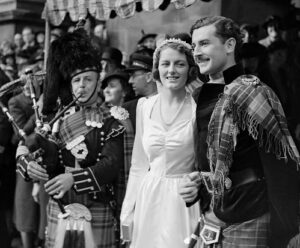 That formative experience with Lord and Lady Lovat, seen here on their wedding day in 1938, taught me a great lesson: whether writing fact or fiction, my job is to let the evidence take this writer wherever it will. Simply tell the story–and damn the torpedeos!
That formative experience with Lord and Lady Lovat, seen here on their wedding day in 1938, taught me a great lesson: whether writing fact or fiction, my job is to let the evidence take this writer wherever it will. Simply tell the story–and damn the torpedeos!
But what if a character in my upcoming novel, That Autumn in Edinburgh, a modern day sequel to the historical novel, Island of the Swans, is based on a descendant of my own ancestor who—it turns out–may not have behaved so nobly? What will my family say….?
More on that sticky subject another time as I knuckle down to the next task at hand…and head for Scotland in June.
Filed under Blog, Ciji's Archives · Tagged with 78th Fraser Highlanders regiment, ancestor search, Black Watch Regiment, Ciji Ware author, Clan Fraser, Cornwall, eighteenth century British history, eighteenth century Scottish history, Fourth Duchess of Gordon, historical fiction, historical novels, Island of the Swans, Jane Maxwell, Lord Lovat of Fraser, Scotland, Simon, That Summer in Cornwall, truth versus fiction
Researching a Novel–Honestly!
May 16, 2013 by ciji · Leave a Comment
![]()
 In less than a month I’ll be heading off on what, to an outsider, probably looks like a lark.
In less than a month I’ll be heading off on what, to an outsider, probably looks like a lark.
Researching a work of fiction might sound like an oxymoron, but as a reporter with more than twenty-five years of experience in the world of “fact checking,” I’ve discovered after seven novels that getting the details right about the real world aspects of a story is just as important in a piece of “make-believe” as it is with “breaking news.” If a novelist screws up the data, believe me, you hear from your readers.
And that’s just as it should be.
In That Summer in Cornwall, the first in the 4 Seasons Quartet series, I’d been to Cornwall several times previously as my English cousin, Gay North, has hosted me in the West Country several times over the years, and especially during the research for an earlier novel, A Cottage by the Sea.
 However, as I embarked on That Summer in Cornwall, I knew virtually nothing about the world of search and rescue, nor about the amazing canines trained to find visitors who fall off the cliffs skirting the English Channel or down abandoned shafts that dot the beautiful countryside. So my trip to Cornwall last October was fun and exciting, to be sure, but it was also spent interviewing the Dog Unit Manager of the Devon and Cornwall Police, to say nothing of tramping up moors, along fast-running rivers, and peering down dark, forbidding mine shafts clinging to remote parts of the local landscape.
However, as I embarked on That Summer in Cornwall, I knew virtually nothing about the world of search and rescue, nor about the amazing canines trained to find visitors who fall off the cliffs skirting the English Channel or down abandoned shafts that dot the beautiful countryside. So my trip to Cornwall last October was fun and exciting, to be sure, but it was also spent interviewing the Dog Unit Manager of the Devon and Cornwall Police, to say nothing of tramping up moors, along fast-running rivers, and peering down dark, forbidding mine shafts clinging to remote parts of the local landscape.
Whatever the setting of a novel—even one that took place in my own backyard of San Francisco–as with A Race to Splendor about the rebuilding of the legendary Fairmont Hotel atop Nob hill after the 1906 earthquake and firestorm–the reportorial skills of “who, what, when, where, and why” are essential to getting the facts right so the world that a novelist creates for the reader rings true.
That Autumn in Edinburgh will be the third book I’ve set in Scotland—Wicked Company being the second and Island of the Swans (the prequel to my next project there) the first. And each research trip to the land of my mother’s ancestors has been a joy–but also involved some rather arduous work as well.
However, this time, the action is set not only in the spectacular city of Edinburgh, which I know well, but also in the Scottish Border country between the capital and the often-contested area of land where England officially begins.
On my upcoming research adventures, I’ll be learning about present-day factories producing ancient tartans; about cashmere manufacture and the struggle to stay afloat in a global economy where operations in the Far East have been allowed to pay their workers $37 a month—and where conditions are so unsafe, entire buildings collapse, killing a thousand women in their wake.
Oh yes…given my experience on trips past, I expect to have a wonderful time visiting a part of Scotland I’ve never seen, but, to me, this story I have percolating in my brain night and day right now is also serious business—and I’ll do my best to get the facts straight.
Filed under Blog, Ciji's Archives · Tagged with 1906 San Francisco earthquake, A Cottage by the Sea, A Race to Splendor, Caerhays Castle, Ciji Ware author, corgis, Cornwall, Cornwall Search and Rescue Team, cottage, Edinburgh, eighteenth century British history, eighteenth century Scottish history, fact checking, Fourth Duchess of Gordon, historical novels, Island of the Swans, Jane Maxwell, researching fiction, San Francisco Chinatown, Sourcebooks, That Summer in Cornwall, Wicked Company, women playwrights
My Mother, The Typist
May 12, 2013 by ciji · Leave a Comment
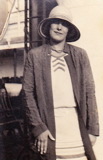 In honor of the Mother’s Day celebrations across the land, I want to pay homage to Ruth Ware, the quintessential Flapper when she graduated on the eve of the Great Depression from Radcliffe College–a school known in her day as the “Harvard Annex.” (Just an aside, but now women graduate from Harvard…)
In honor of the Mother’s Day celebrations across the land, I want to pay homage to Ruth Ware, the quintessential Flapper when she graduated on the eve of the Great Depression from Radcliffe College–a school known in her day as the “Harvard Annex.” (Just an aside, but now women graduate from Harvard…)
We have long heard stories from friends like Maggie Richardson (on right, slanted hat–a newspaper woman in the 1940s and later editor for the Women’s Section at the old Los Angeles Examiner), that Ruthie may have been “one smart cookie,” but never let an approaching exam keep her from a good party at the Harvard Law School!
 The daughter of wealthy parents in Chicago, her graduation present was a trip around the world on an ocean liner, arriving back home October 1. On October 29th, the Crash of ’29 hit with such force that her father, who had invested most of his money “on margin,” lost the majority of his investments and, eventually, control of a washing machine company of which he was then president.
The daughter of wealthy parents in Chicago, her graduation present was a trip around the world on an ocean liner, arriving back home October 1. On October 29th, the Crash of ’29 hit with such force that her father, who had invested most of his money “on margin,” lost the majority of his investments and, eventually, control of a washing machine company of which he was then president. 
As breadlines became a common sight on city streets, the family moved to a cold water flat on La Salle Street. My grandmother reportedly had a nervous breakdown, my grandfather, who’d moved to Seattle to establish an insurance company, died mysteriously in a hotel, and Mom’s kid brother was told there would be no college education in his future.
 Ruthie immediately talked her way into a job as a switchboard operator in the Chicago law firm run by the father of her then-boyfriend—a charming young buck who immediately dropped her and married someone else. During those next tough years, my mother kept her mother in food and shelter and helped pay the tuition for her kid brother to remain in the Parker School, a posh private high school she’d also attended. Fortunately, their great uncle housed her brother while he earned his own way through a teacher’s college in Missouri.
Ruthie immediately talked her way into a job as a switchboard operator in the Chicago law firm run by the father of her then-boyfriend—a charming young buck who immediately dropped her and married someone else. During those next tough years, my mother kept her mother in food and shelter and helped pay the tuition for her kid brother to remain in the Parker School, a posh private high school she’d also attended. Fortunately, their great uncle housed her brother while he earned his own way through a teacher’s college in Missouri.
Certainly, the 1930s were a far cry from my mother’s carefree 1920s when she wore stylish cloche hats, danced the Charleston all night, and appeared in amateur college theatricals (Ruth is second from left).
But lest we get too dewy-eyed at this juncture, it’s important to note that my mother was certainly no sentimentalist. This was the woman who, as Captain of the Girls Basketball Team, played the championship game with a broken arm! And as regards the annual celebrations of the mothers of this world, my mother considered Mother’s Day a “Hallmark Holiday, created solely to sell greeting cards–an idea the industry sold to their cronies in Congress.” No fluffy, romantic was Ruth Ware. True grit describes her best.
Her life story was a common one for women who were in their maturity in the 1950s: she ultimately became a wife and mother–and typist for my father, Harlan Ware, whom she met–where else?– at an office Christmas party.
By the time the two became engaged, my dad was launching into a successful career as a writer of films, short stories, radio dramas, novels, and ultimately television (though he hated the medium). He was of the opinion that writers–“to be real pros”–had to be willing to write anything and everything that could support a family of five, not to mention a couple of hangers-on relatives that traveled in our wake….
But was my mother merely the one who typed the final copy of whatever manuscript my father had on deadline that week? During their nearly forty years of marriage, she was right by his side, absorbing the sights and drama of their life together in Hollywood, and later, Carmel-by-the-Sea. Was she just the scribe who dutifully corrected his spelling and punctuation and never added or word of phrase of her own? Could this very brainy lady resist making a suggestion or two, or thinking, as she typed, typed, typed everyday upstairs in his office when he headed out to walk the Carmel Beach with our dog to clear his head, that a paragraph or two needed some serious editing–and then just do it?
 Having lived myself for nearly four decades with a fellow writer, I cannot believe she didn’t collaborate with him in some significant ways. Over the years, Tony and I certainly have, exchanging our work, making sometimes unwanted suggestions scribbled with our proverbial red pencils, but always admitting to each other afterward that what we’d produced was better for having been looked over by two sets of eyes before “the world” could make its critique.
Having lived myself for nearly four decades with a fellow writer, I cannot believe she didn’t collaborate with him in some significant ways. Over the years, Tony and I certainly have, exchanging our work, making sometimes unwanted suggestions scribbled with our proverbial red pencils, but always admitting to each other afterward that what we’d produced was better for having been looked over by two sets of eyes before “the world” could make its critique.
My father often said that he was stunned he’d wooed and won a woman of such major intelligence and classical education–and he adored her. I remember him gazing at her one time when we were in the car, motor running, waiting for her to close the garage door. He said that day, “Marrying your mother was the luckiest thing that ever happened to me.” Was his statement purely personal, and had nothing to do with his profession? Hmmmmm…
Sadly, both of my parents died when I was in my twenties, and because I, too, became a professional writer, I probably mention my father far more often in casual conversation than I do my mom.
However, I think it’s about time I gave my mother her due. If she had lived in a different era, she could have been CEO of Facebook. Really. She was that sharp. And I have no doubt that–as writer Irving Stone‘s wife admitted after the death of the author of Lust for Life and other bestselling tomes–I suspect Ruth Ware did a lot more than just correct Harlan Ware’s typos.
 So Hallmark Holiday or not, Happy Mother’s Day, Mom….I salute and thank you for your high standards and demands for excellence, your mid-Western good sense, and your amazing grace under pressure.
So Hallmark Holiday or not, Happy Mother’s Day, Mom….I salute and thank you for your high standards and demands for excellence, your mid-Western good sense, and your amazing grace under pressure.
Filed under Blog, Ciji's Archives · Tagged with author Harlan Ware, author Ivring Stone, California, Carmel, Ciji Ware author, Hallmark Cards, Harvard Law School, Harvard University, Irving Stone, Lust for Life, Mother's Day, Radcliffe College, The Great Depression
-
Recent Posts
Ciji’s Archives






